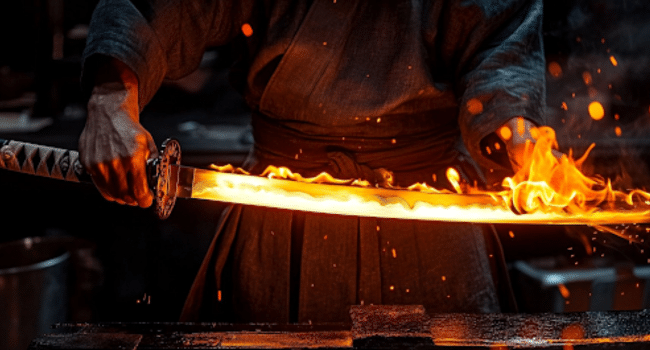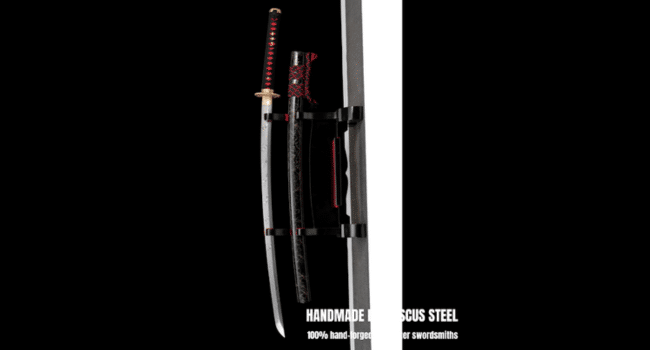Table of Contents
The katana, that most iconic of Japanese swords, is way more than just a battle-hardened blade – it’s a slice of history, a symbol of honor, and a work of art that’s steeped in tradition. It’s not surprising that people are curious about its many layers – and the answer is a fascinating glimpse into the artistry and engineering that goes into making this legendary sword.
This guide is going to take you on a journey through the intricate process of katana steel forging, and explain just how the layering of steel contributes to the sword’s remarkable properties – and give you a solid answer to the question: how many layers are in a typical samurai sword?
A Sword Shaped by History
The development of the samurai sword started to take shape during the Heian period (794-1185) – before that, swords in Japan were typically straight-bladed. But as warfare changed and cavalry became more prominent on the battlefield, the need for a more slashing-effective weapon grew. This led to the creation of the curved tachi, which would eventually become the katana.
For the samurai, their sword was more than just a tool – it was an extension of themselves. The concept of bushido, or the way of the warrior, made the sword a symbol of a samurai’s honor, discipline, and loyalty. A samurai’s swords were often passed down through generations, and this cultural reverence drove the pursuit of perfection in Japanese sword-making.
The Steels of the Samurai Sword
The secret to the katana’s unique combo of a razor-sharp edge and a resilient body lies in the use of two different types of steel, carefully forged together in a masterclass display of metallurgy. The traditional steel used is called tamahagane, or jewel steel – produced in a clay furnace known as a tatara.
The Two Steels of the Katana
- Shingane (Core Steel): This is the softer, lower-carbon steel that makes up the inner core of the blade. Its primary role is to provide flexibility and shock absorption – this keeps the sword from shattering upon impact, giving it the resilience it needs to take a beating.\
- Kawagane (Outer Steel): This is the harder, higher-carbon steel that forms the sharp edge and the tough outer jacket of the sword. The kawagane is what lets the katana be sharpened to such an incredible degree – and maintain its edge even after heavy use.
- The fusion of these two steels produces a blade that’s both crazily sharp and remarkably tough – a combination that was revolutionary for its time, and remains unmatched to this day.
The Art of Folding: Katana Forging
Forging a katana is an ancient art that’s steeped in tradition and precision. One of the most critical steps in creating the kawagane is the repeated folding and hammering of the steel. This technique serves a couple of crucial purposes in Japanese Swords making.
First, it helps to get rid of impurities from the tamahagane. The raw steel from the tatara isn’t uniform – it’s got slag and other imperfections in it. By heating, hammering, and folding the steel, the swordsmith can flush these impurities out of the metal.
Second, the folding process distributes the carbon content evenly throughout the steel. This is key to creating a blade with consistent hardness and strength. The swordsmith takes their time folding the steel, welding it back together with each pass, making sure the carbon is perfectly integrated.
How Many Layers in a Samurai Sword?
The folding process is where it all comes together – and creates the astonishing number of layers that make up a katana. Each time the steel is folded, the number of layers doubles. A swordsmith starts with a single block of steel.
- 1 fold = 2 layers\
- 2 folds = 4 layers\
- 3 folds = 8 layers\
- 4 folds = 16 layers\
- 10 folds = 1,024 layers\
- 15 folds = 32,768 layers\
- 16 folds = 65,536 layers
A typical katana is folded between 15 and 20 times – which gives it a blade with an almost inconceivably large number of layers – ranging from 32,768 to over one million. Some historical examples even have up to two million layers. But here’s the thing – you don’t need a million layers to make a great sword – you need the perfect balance – and that’s something a master swordsmith has to figure out for themselves.These thousands of microscopic layers build up a complex internal structure that plays a huge part in the blade’s legendary strength and ability to resist fracture.
Creating the Edge: Differential Hardening

After the blade is forged and shaped, it goes through another critical process called differential hardening. This process is the one that creates that beautiful and distinctive temper line, or hamon, you see on the blade.
The swordsmith carefully slaps a special mixture of clay, charcoal powder and other secret ingredients onto the blade, and a thick layer goes on the spine and sides while a pretty thin layer gets applied to the edge. The sword then gets heated to a super precise temperature and then quenched in water.
The thin layer of clay on the edge cools really quick, which forms a rock hard crystalline structure called martensite, while the thicker clay on the rest of the blade cools more slowly, creates a softer, more flexible pearlite structure. The end result is a blade with a razor sharp, super hard edge and a spine that can absorb shocks without breaking. The hamon is the visible bit where these two zones meet.
The Signature of the Smith
The tang of the sword, or nakago, is that bit that sticks out of the hilt. This unpolished section is one of the most important parts of the sword’s identity. That’s where the swordsmith would usually carve their name, or mei, along with info about when and where the sword was made. For collectors and historians, the mei is an invaluable tool for figuring out where the blade came from, and who made it. It gives you a direct link to the person who made the sword.
Looking after a Legacy
A samurai sword is a historical artifact that needs looking after, otherwise it’ll just fall apart. To stop rust from taking hold, you need to clean the blade with a soft cloth and slather on a thin layer of oil specifically designed for the job – like choji oil. It should be kept in its scabbard (saya) in a dry, stable place. If you do that, the intricate layers and the edge of the blade will be preserved for generations to come.
A Masterpiece of Steel
The number of layers in a samurai sword is a testament to the amazing skill and knowledge that Japanese swordsmiths have when it comes to metalwork. By folding steel thousands and thousands of times, they created a weapon that was not just deadly but also a work of art. You get a sword with a soft, resilient core and an outer jacket that’s hard as nails, all thanks to differential hardening. The end result is a blade that’s captivated people the world over. The katana is more than just steel and fire – it’s a manifestation of a culture that lives and breathes precision, beauty and the warrior spirit.
